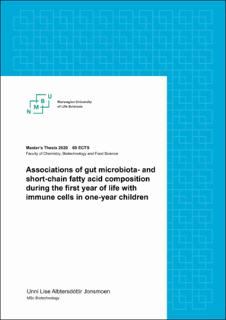| dc.contributor.advisor | Rudi, Knut | |
| dc.contributor.advisor | Nilsen, Morten | |
| dc.contributor.author | Jonsmoen, Unni Lise Albertsdóttir | |
| dc.date.accessioned | 2020-09-25T14:16:57Z | |
| dc.date.available | 2020-09-25T14:16:57Z | |
| dc.date.issued | 2020 | |
| dc.identifier.uri | https://hdl.handle.net/11250/2679776 | |
| dc.description.abstract | Mikroorganismene i tarmen etablerer komplekse mutualistiske forhold til verten og spiller en viktig rolle i modningen av vertens immunsystem. Modningsprosessen påvirkes enten direkte av bakterielle komponenter eller indirekte gjennom bakterienes fermenteringsprodukter slik som korkjedede fettsyrer. Med dette som grunnlag utforsker denne studien den langsgående utviklingen av tarmmikrobiotaen og nivået av kortkjedede fettsyrer hos barn gjennom deres første leveår, og ser det i sammenheng med barnas immuncelleprofiler ved ett års stadiet.
Fekale prøver fra 180 12 måneder gamle barn ble hentet fra studien Prevent Atopic Dermatitis and Allergies (PreventADALL). Immuncellekomposisjonsdata ble mottatt for 67 av barna og disse barna ble studert langsgående ved analyse av fekale prøver hentet fra barnas mødre i svangerskapets 18. uke, og fra barna ved 0-, 3-, 6- og 12 måneder. Bakterie- og kortkjedet fettsyresammensetning ble bestemt ved henholdsvis nestegenerasjonssekvensering og gasskromatografi. Informasjonen om immuncellesammensettingen ved 12 måneder ble brukt videre i den statistiske analysen. Bakteriedataene ble behandlet gjennom QIIME-pipeline. Videre dataanalyse ble utført ved paret t-tester og Spearman korrelasjonsanalyse justert for multippel testing.
Studien avdekket sammenhenger mellom immuncelleprofiler og miljøassosierte bakterier. Funnene viste at både Methylophiliales og Methylococcales påvirket vertens immuncellekomposisjon, på en henholdsvis pro- og anti-inflammatorisk måte. Det ble ikke avdekket korrelasjoner mellom kortkjedede fettsyrer og immunceller, noe som hadde vært forventet utfra dyrestudier. Som i tidligere studier, viste den mikrobielle sammensetningen at Enterobacteriales dominerte i barnas første avføring, mens Clostridiales dominerte i mødrenes tarmer. Mengden eddiksyre endret seg i samsvar med mengde eddiksyre-produserende Bifidobactierales ved alle aldere. Positive korrelasjoner ble påvist mellom Lactobacillales og smørsyre ved 3-, 6- og 12 måneder, noe som kan skyldes bakterielle kryssfôringsmekanismer.
Oppsummert avdekket denne eksplorative studien korrelasjoner mellom enkelte immunceller og tarmbakterier. Miljøassosierte bakterier påvirket vertens immunsystem på ulike pro- og anti-inflammatoriske måter. Det er et behov for videre forskning på forbindelsen mellom tarmmikrobiotaen og immunsystemet i friske mennesker, og denne studien taler for at miljømikroorganismer i større grad bør vektlegges i slik forskning. | en_US |
| dc.description.abstract | The microorganisms in the gut establish complex mutualistic relationships with their human host and serve important functions in the maturation of the host’s immune system. The immune system maturation process is affected both by bacterial components directly and through their fermentative products, such as the short-chain fatty acids. This thesis aimed to explore the longitudinal development of the infant gut microbiota and short-chain fatty acid (SCFAs) concentrations in relation to the immune cell status at 12 months.
Fecal samples from 180 12 months-old infants were retrieved from the Prevent Atopic Dermatitis and Allergies (PreventADALL) study cohort. Data on immune cell profiles were obtained for 67 of the infants, and these infants were studied longitudinally with fecal samples from the mothers 18-weeks pregnant, and the infants at 0-, 3-,6- and 12 months were analyzed. The bacterial and SCFA composition was determined by next-generation sequencing, and gas chromatography, respectively. The immune cell data was used in statistical analysis. The bacterial data was processed using the QIIME pipeline, and further statistical analysis was conducted using paired t-tests and Spearman rank’s correlation adjusted for false discoveries.
This study revealed interesting correlations between immune cell profiles and environmental associated bacteria. The orders of Methylophiliales and Methylococcales both affected the immune cell profiles in pro- and anti-inflammatory manner, respectively. No correlations between SCFAs and immune cells were detected, which would have been expected based on animal studies. With respect to the general age-related development of the microbiota did the findings of this study correspond to previous studies. Enterobacteriales dominated the meconium samples and Clostridiales dominated in the mothers. Acetate levels coincided with the abundance of the acetogenic Bifodobacteriales in all age groups. Positive correlations were detected between Lactobacilliales and butyric acid at 3-, 6- and 12 months, which was likely caused by bacterial cross-feeding mechanisms.
This exploratory study reviled correlations between immune cells and gut bacteria. Environmental associated bacteria affected the immune system and influenced both pro- and anti-inflammatory associated responses. There is a need for further research on the connection between the gut microbiota and the host’s immune system in healthy humans, and this study notes the importance of including environmental associated bacteria in this research. | en_US |
| dc.language.iso | eng | en_US |
| dc.publisher | Norwegian University of Life Sciences, Ås | en_US |
| dc.rights | Attribution-NonCommercial-NoDerivatives 4.0 Internasjonal | * |
| dc.rights.uri | http://creativecommons.org/licenses/by-nc-nd/4.0/deed.no | * |
| dc.subject | gut microbiome | en_US |
| dc.subject | short-chain fatty acids | en_US |
| dc.subject | gas chromatography | en_US |
| dc.subject | next-generation sequencing | en_US |
| dc.subject | immune cell profiles | en_US |
| dc.title | Associations of gut microbiota- and short-chain fatty acid composition during the first year of life with immune cells in one-year children | en_US |
| dc.type | Master thesis | en_US |
| dc.subject.nsi | VDP::Matematikk og Naturvitenskap: 400::Basale biofag: 470::Molekylærbiologi: 473 | en_US |
| dc.subject.nsi | VDP::Matematikk og Naturvitenskap: 400::Basale biofag: 470::Generell mikrobiologi: 472 | en_US |
| dc.subject.nsi | VDP::Matematikk og Naturvitenskap: 400::Basale biofag: 470::Generell immunologi: 478 | en_US |
| dc.source.pagenumber | 90 | en_US |
| dc.description.localcode | M-BIOTEK | en_US |

